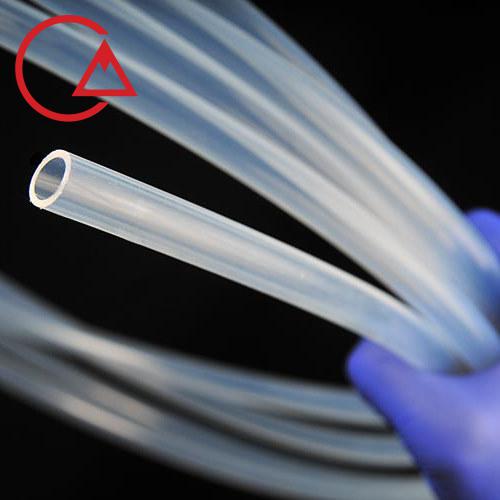
| Structural formula | |||||||
|---|---|---|---|---|---|---|---|
 | |||||||
| General | |||||||
| Surname | Fluoroethylene propylene | ||||||
| other names |
| ||||||
| CAS number | 25067-11-2 | ||||||
| Monomers /partial structures | Tetrafluoroethylene, hexafluoropropylene | ||||||
| Short description | white to transparent, also yellowish/brownish, odorless solid [1] | ||||||
| Characteristics | |||||||
| state of aggregation | fixed [1] | ||||||
| density | 2.1–2.3 g/cm 3 (DIN 53479) [2] | ||||||
| melting point | 253-282°C (ISO 11357-1/3) [2] | ||||||
| solubility | practically insoluble in water [1] | ||||||
| Chemical resistance | > 420 °C [2] | ||||||
| safety instructions | |||||||
| |||||||
| SI units are used wherever possible and common . Unless otherwise noted, the data given applies to standard conditions . | |||||||
Tetrafluoroethylene-hexafluoropropylene copolymer ( abbreviation FEP , perfluoro(ethylene-propylene) , also called fluoroethylene-propylene ) is a copolymer made from the monomers tetrafluoroethylene and hexafluoropropene . It is used when resistance to extreme temperatures or chemicals is required.
History
FEP was brought to market by DuPont as part of its product development in the 1950s to bring a fluorocarbon plastic with more favorable thermal forming and processing properties than those of Teflon (PTFE). The non-proprietary abbreviation FEP soon became synonymous with this plastic , which DuPont added to its range of perfluorinated hydrocarbon polymers around 1960. Since DuPont’s patent rights expired, FEP has also been produced by other manufacturers worldwide. In more recent literature, the abbreviation PFEP is used for the plastic instead of FEP as a synonym for perfluoro(ethylene-propylene), which corresponds better to its chemical structure. [2]
Properties
The thermoplastic is not flammable, but decomposes at higher temperatures, such as in the event of a fire, releasing corrosive and highly toxic fire gases. [3]
FEP is stable to almost all chemicals, and the plastic is also extremely weather-resistant and radiation-resistant. [2]
| Thermal conductivity | 0.21–0.25 W/K m [2] |
| Melting temperature | 257-263°C [4] |
| Processing temperature | around 370 °C [2] |
| Decomposition temperature | ≥ 420 °C [2] |
| spec. Heat capacity | 1.12–1.17 kJ/K kg [2] |
| min. operating temperature | −200 °C [2] |
| max. operating temperature | 205°C [2] |
Areas of application
Fluoroplastics such as FEP and PFA are used due to their
- Flexibility,
- good weldability,
- high temperature resistance,
- excellent chemical resistance,
- Usability in the low temperature range,
- Usability in high-purity applications,
- long lifespan,
- electrical resistance and
- simple thermoplastic processing
Used in a variety of proven ways in the chemical processing industry, pharmaceutical industry, semiconductor construction and for exhaust gas purification. They are used as media-resistant liners for lining steel containers [5] as well as for the construction of dual laminate containers and tanks [5] , in pipeline construction [5] and for sealing systems. [6] Semi-finished products and panels made of FEP are also used in a variety of ways to protect system components ( valves , heat exchangers , pipes, etc.) from corrosion.